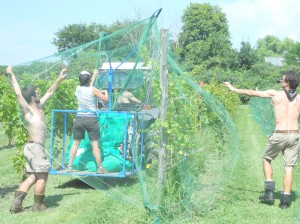
Shelburne Vineyard and Marquette grapes as harvest approaches.
By George Harvey
The thoughts that come up when we consider Vermont agriculture include dairy products, maple syrup, apple cider, and vegetables from small farms. One thing that does not come readily to mind is grape wine. Perhaps that will change, as we have the exemplary Shelburne Vineyard to teach us.
Shelburne Vineyard started on three acres Ken Albert leased and planted with grapes in 1998. It was not his first experience with grapes. He had already been growing them for about two decades as a hobbyist. As an IBM engineer, he often had gone to Quebec, and became convinced that Vermont could have an industry using similar grapes and viticulture techniques.

Dispensing the netting to protect ripening grapes from Birds
In 1999, he leased another three acres and planted more grapes. The following year, he took on Scott Prom as a partner. Prom was also an engineer, but had years of experience making wine in WashingtonState. Together, they produced their first vintage in 2001. Since then, the vineyard expanded to17 acres.
The winery was built to LEED standards, though it is not yet certified. There are eight inches of insulation in the building. Ventilation is carefully designed for heat retention. The lighting in the processing area is all from fluorescent fixtures with motion detectors, so the lights shut off automatically when no one is in the room. The building was designed to take advantage of natural lighting, however, so the lights are often not needed. Hot water is produced in highly efficient on-demand heaters. Materials were chosen based partly on where they are from; the bar in the wine-tasting room is from a nearby woods, and the fixtures are the product of local craftsmen.
The University of Vermont’s Sustainable Agriculture Program named Shelburne Vineyard “Sustainable Farm of the Year” in 2009.

Shelburne Vineyard Tasting Room with Bar crafted from a local cherry tree, copper fixtures crafted by a Charlotte craftsman and floors formed from polished concrete infused with local stone. Courtesy Shelburne Vineyard.
Ken Albert’s intention was that Shelburne Vineyard be organically certified. That proved to be impossible because all of the country east of the Rocky Mountains has enough humidity to support the black rot mildew, for which there is no organically acceptable treatment. CornellUniversity has a very strict protocol, however, which allows for a very narrowly focused treatment for the mildew, and is quite possibly the best solution available for vintners who would be certified as organic. That protocol is what Shelburne Vineyard follows.
The grape varieties Albert uses at the vineyard were those developed to be grown in cold places like Quebec and Minnesota. They are hybrids of American and European stock, though he carefully explains that they are not of the species of American grapes people call “foxy.” The wine tastes more like European wines and not at all like Concord grapes.
Some of the grape varieties that are used are rather unusual. One of these is the Arctic Riesling. The grapes are very sweet and can stay on the vine into cold weather. They are harvested at 15° F, at which temperature much of the water in the grape is frozen, concentrating the sugar into what remains. The grapes are pressed while frozen, and this is used to create a sweet product called, “ice wine.”
The grapes are grown using practices that are as sustainable as possible. The rows have enough room between them that a tractor can pass, pulling a special hoe that cuts weeds down an inch below ground level. This causes as little disturbance as possible to the soil and eliminates the need for herbicides.
To make the wine, the vineyard uses only traditional yeasts of the same natural species used for centuries for beer, wine, and mead. During fermentation, the natural heat of fermentation is closely controlled to produce the highest quality wine. The stainless steel fermenting tanks have cooling jackets wrapped in insulating blankets to save on electrical energy consumption.
Bottles used in the vineyard are of types chosen because they are light. This means that less glass is used, so the embodied energy is reduced. Less weight also means that shipping the bottles uses less fuel. The corks are chosen to produce the highest quality wine while being as environmentally friendly as possible. Solid cork is used for the top and bottom, with a composite for the middle section. This optimizes the use of the cork bark. The cork comes from sustainably raised cork-oak trees in Portugal, whose bark regrows and can be harvested from the same tree on a 9 year cycle through generations.
Shelburne Vineyard has about 17 acres of grapes, with about 804 vines per acre. They produce 40 tons of grapes each year, for 3000 cases of wine. The wine is available at the vineyard and at selected retailers throughout Vermont and New Hampshire. The vineyard also sells products of other farms, including cider and mead.
The owners of the vineyard are proud of the support they give to the local Chittenden Emergency Food Shelf. Each year they host a benefit wine tasting for which people are invited to donate non-perishable food or cash instead of paying for wine tastings. The donations are the equivalent of 2000 to 3000 pounds of food. This year, the event is on Saturday, November 8 from 11:00 a.m. to 5:00 p.m.
The Shelburne Vineyard is in Shelburne Vermont. The number is 802-985-8222, and the website is shelburnevineyard.com.








Leave a Reply